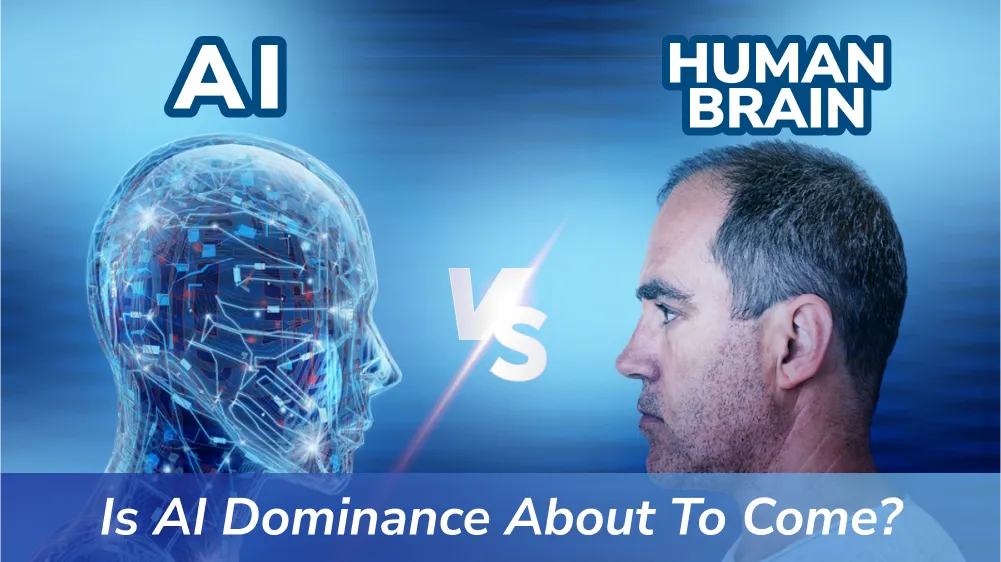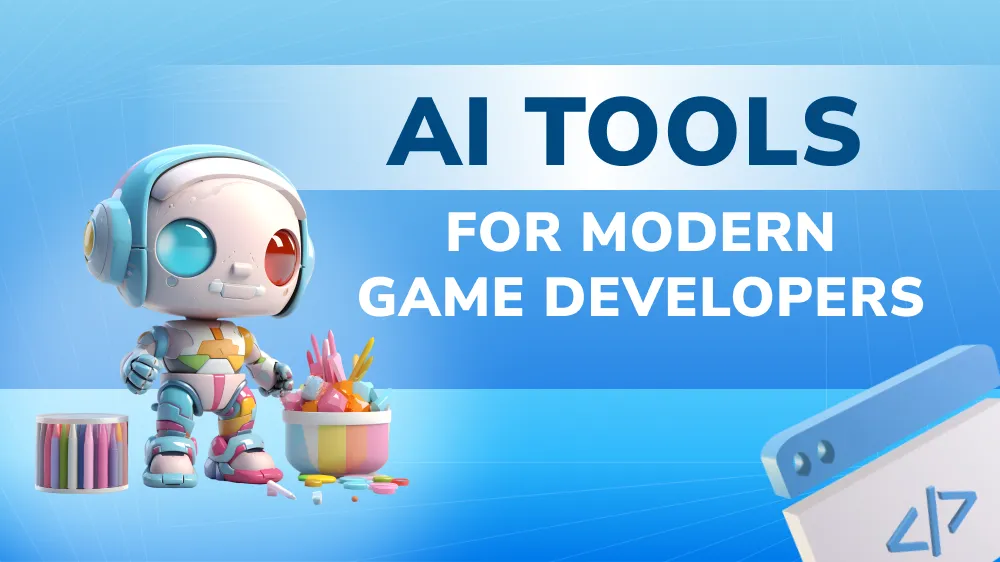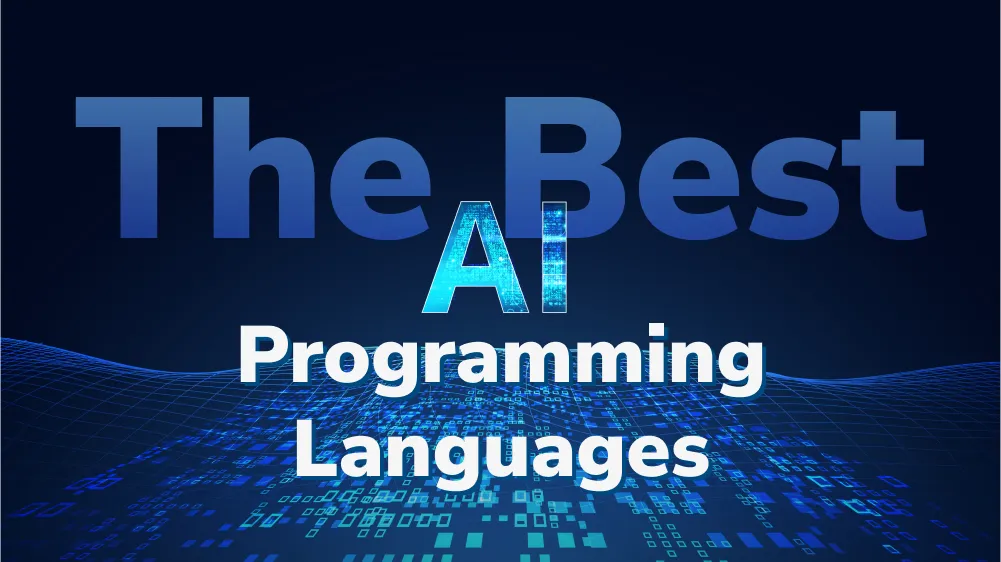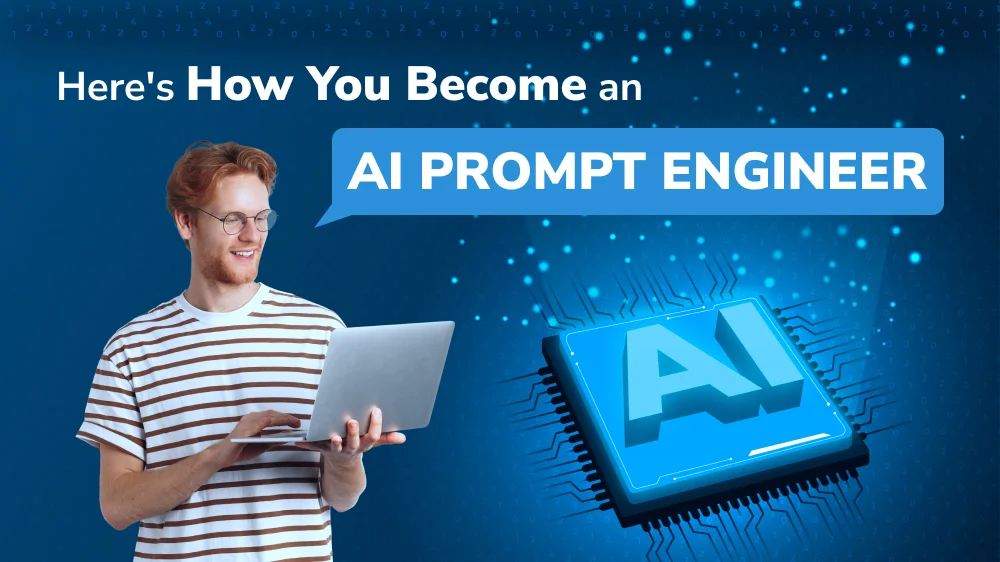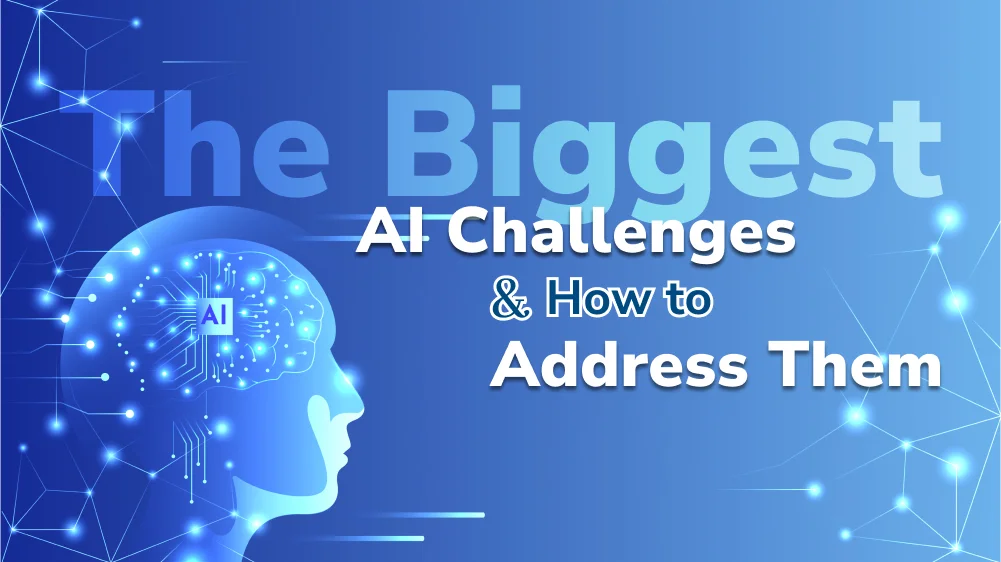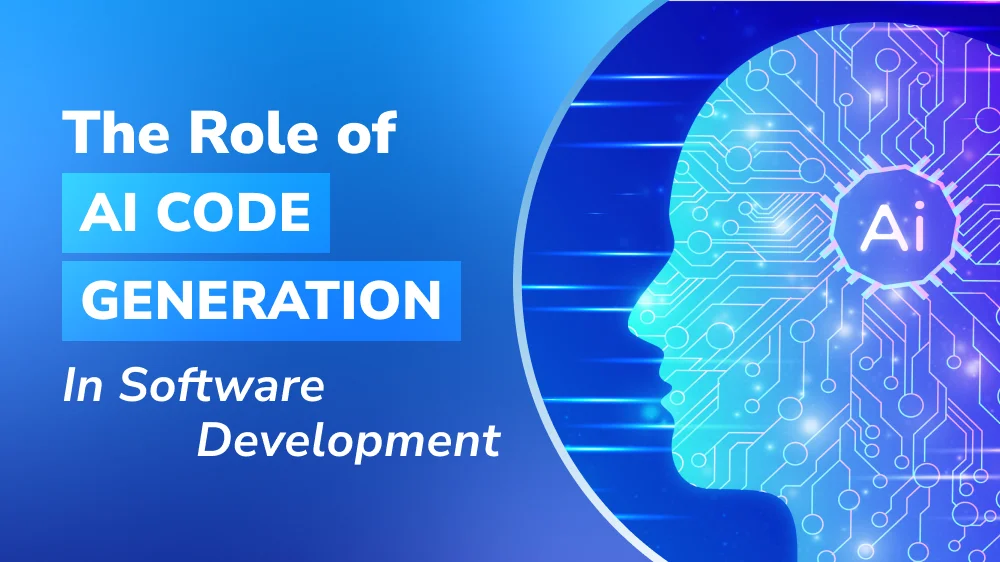How to Build AI Software Fast without Compromising Quality
It seems as though every business has recently wanted to give AI a go. Yet, how to make an AI like ChatGPT leaves entrepreneurs with great concern. What to know about this technology, where to start your AI development process, how much it costs, and ways out of AI challenges will all be revealed in this article.
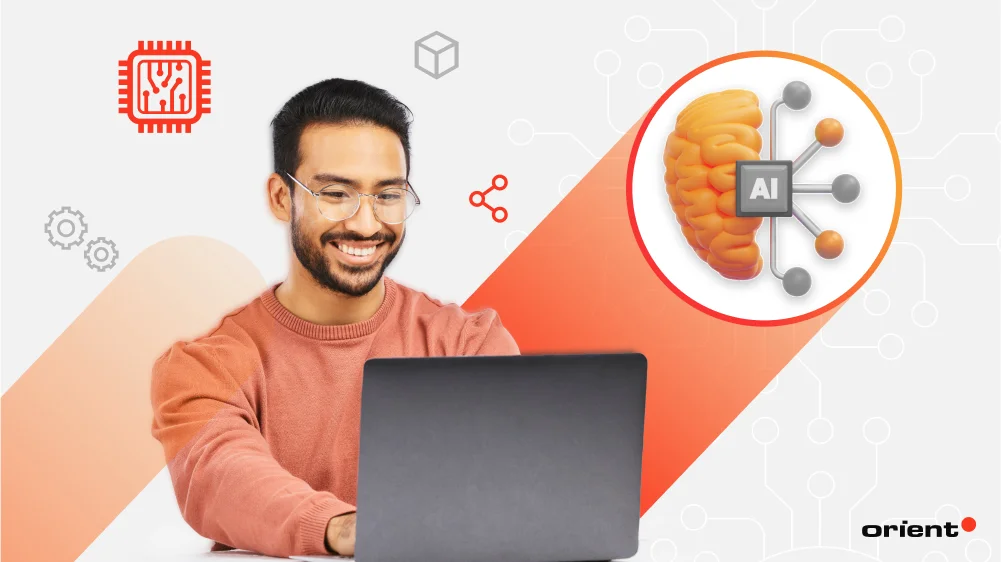
Content Map
More chaptersThe emergence of artificial intelligence (AI) technologies is undeniable. AI capabilities will gradually become the golden standard many software development projects want to build. For businesses wishing to leverage AI, there are two options:
- Buy AI solutions, i.e., AI as a Service (AIaaS), from large tech enterprises such as Microsoft, Amazon, IBM, or Google.
- Build your own AI software.
Buy existing systems or build your own artificial intelligence software is a difficult decision. It would be perfectly acceptable if you chose to use any off-the-shelf app on the market for the sake of convenience, as it is simply a normal purchasing action.
However, things get more complicated when you opt to create one. Developing AI software is a challenging journey that requires businesses to navigate a bunch of complex technical hurdles to achieve freely customizable features with absolute fit. It will be a significant investment that, once successful, will bring lasting impact.
But how daunting can such a process be? In this article, we give you the most easy-to-digest guidelines on how to build AI software fast without compromising product quality and share the necessary information for success.
A Quick Tour of the Global AI Market
Despite a slight decline in AI private investment compared to the record highs of 2021, the global AI market has maintained steady growth, with long-term investment trajectory remaining strong. This cutting-edge technology, in combination with various groundbreaking technological advancements, has changed the landscape of the world and the way business owners across companies, large and small, operate their companies.
More than just rule-based systems like basic chatbots that answer questions based on predefined rules, AI’s transformative potential expands across other areas, such as automation and analytics, transforming most sectors, including healthcare, finance, education, manufacturing, and entertainment. AI detects and prevents copyright infringement, and AI provides personalized lecture customization for each student’s needs, which are just a few of the hundreds of other applications of AI in life.
To get a more general view of the global AI market, let’s take a look at some interesting statistics about this technology:
- The AI market size is projected to reach US$184.00bn in 2024. (Statista)
- North America held the largest global AI market share of 36.9% in 2024. (Grand View Research)
- The generative AI market is expected to expand to $1.3 trillion by 2032, up from a market size of only $40 billion in 2022. (Bloomberg)
- Generative AI could enable labor productivity growth of 0.1 to 0.6% annually through 2040. (McKinsey)
- By technology insight, the deep learning segment contributed the biggest market share of 36.9% in 2023. (Yahoo Finance)
Understanding How AI Models Work
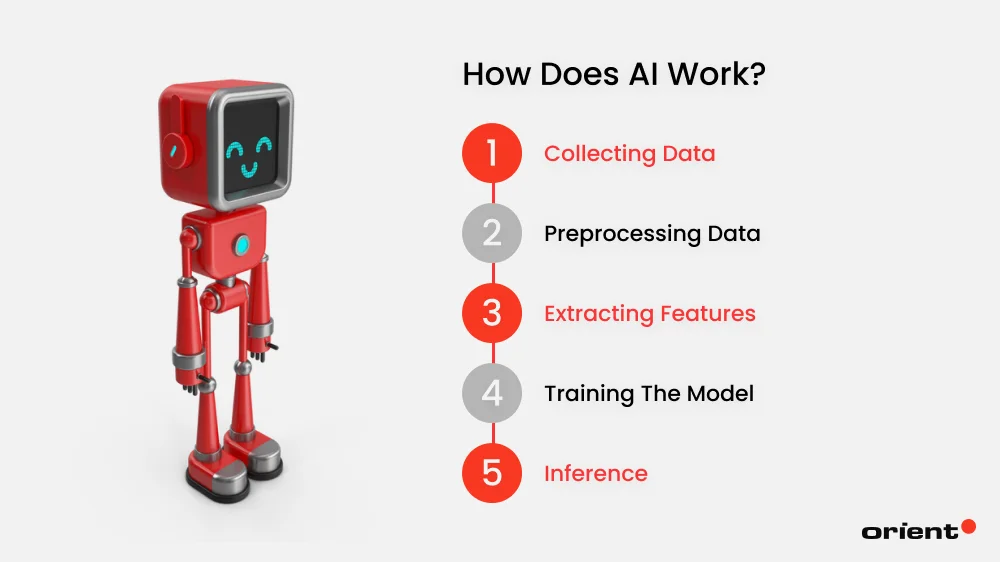
Most basic users know the concept of AI through the popularity of ChatGPT. However, have you ever wondered how it works to give us answers of all types so quickly?
Step 1: Collecting Data
In light of the widespread digital transformation, much of today’s activity has transitioned online, resulting in the continuous generation of new data every second. Just as data scientists make use of this large data set coming from databases, sensors, APIs, or websites for analysis and research, AI software also collects this meaningful data source to form the basis for the entire model.
In this step, the collected data can exist in many different forms, from structured and unstructured to semi-structured data, as they all potentially contain helpful insights for later phases.
It is worth noting that the data collection step is required to be performed by developers or data engineers with the help of supporting tools instead of the AI model itself. This ensures that the collected data is always well-aligned with business goals and objectives, limiting data that is not relevant to the AI model’s purpose.
Step 2: Preprocessing Data
Data quality matters as AI will then learn from the input data to perfect its own models. In other words, data quality directly affects the final quality of AI models. While raw data can be broad, preprocessing is a necessary process that helps AI systems remove noise, unwanted data types or formats and keep only usable formats for further processing, like feature extraction or training.
For example, for text data, preprocessing will remove unrelated sections, including HTML tags or stop words, to ensure the best quality data is obtained. Failure in this process can lead to poorly trained models and deeply affect the performance of the AI system in the end.
Step 3: Extracting Features
From the clean data collected in the preprocessing step, the AI model continues to analyze them again and identify which are the most informative parts of the data for problem solving. Simply put, feature extraction focuses on isolating the most relevant attributes for training the model.
For instance, for real estate-related tasks such as house price prediction, this step helps artificial intelligence software select and keep only relevant data, such as location or square footage, while ignoring noisy data, such as the homeowner’s name.
This process is repeated for each task the AI model receives. However, as the specific task requires features tailored to its goals, the AI model when extracting features, must be adjusted accordingly without using the same previous formula.
Step 4: Training the Model
The AI model will go through a process of continuous learning from the feature-extracted data prepared in earlier steps to provide appropriate and accurate predictions and answers for each fixed task using a machine learning algorithm (e.g., linear regression, neural networks). The task of the AI model at this stage is to learn from millions of provided examples to be able to understand the relationship between the data and their patterns.
In the initial phases, the provided results based on the input data may be correct, close to correct, or even not. However, the accuracy of the response will increase over time as AI models continuously compare their predictions to ground truth and calculate errors, thereby self-improving using optimization algorithms like gradient descent after each answer is provided.
Step 5: Inference
After going through all the above steps, the AI model is ready to make predictions and perform tasks in real-world scenarios. This is the stage where the AI model applies all the knowledge it has learned to process and give appropriate responses to user requests.
The specific process is as follows: the model receives input from the user which can be a query or an image, the model processes these data layer by layer based on learned knowledge, the model generates responses and continuously improves the quality of the output over time by collecting user feedback, updating new data, and identifying gaps.
For tasks in the scope of Q&A, the AI model, a chatbot, for example, uses natural language processing (NLP) to provide appropriate answers. Meanwhile, the model applies computer vision to handle image classification tasks.
What Business Problems Can Be Addressed with AI?
Interest in generative AI has brightened the spotlight on a broader set of AI capabilities. Although AI adoption has been adjusted up and down every year, the overall trend of the global market is still upward compared to the 2017s. Statistics never lie. Positive figures related to AI published every year further confirm the position of this technology. Integrating AI into operations is now a must rather than an option.
The chart below shows the strong growth of AI adoption in the production cycle and operations of multi-industry companies. Many respondents indicated that they have used AI across two or more business functions rather than limiting its application to a single area.
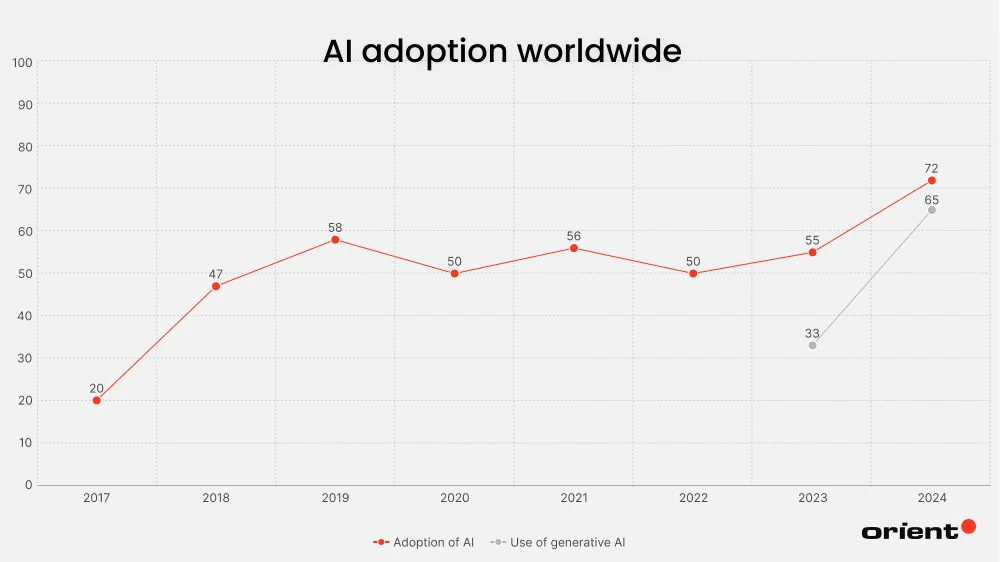
Specifically, what difficulties have implementing AI systems helped businesses solve? What are the benefits of this technology?
- Minimize manual processes that slow down operations.
- Automate certain tasks quickly and efficiently.
- Provide timely customer services and personalized user experiences.
- Detect fraudulent activities in real time using cyber security tools.
- Simplify large data handling and insight extracting.
- Automate audit transactions and ensure regulatory compliance.
- Create new ideas, content, designs, or marketing copy based on existing data.
When Should You Build Your Own AI System?
You should build your own AI software when AI capabilities form the backbone of your business. To make this decision, consider the following supporting reasons.
- The subscription model of AIaaS, like any SaaS, is known to cost more in the long term.
- AIaaS puts a data limit that obstructs you from scaling up.
- A custom AI solution that best fits your business needs without waiting for customer service and complete control.
- More control over risks such as data security and storage, technical issues, and downtime. This is important not just for ESG reporting; your customers and shareholders will expect better risk management in turbulent times.
- You own the AI model, data, and assets and can modify or rent them out as needed.
If you find these reasons convincing enough, read the rest of the article to see the main steps in building an AI software product, especially building an AI team.
AI Development Process: How to Create AI Software from Scratch
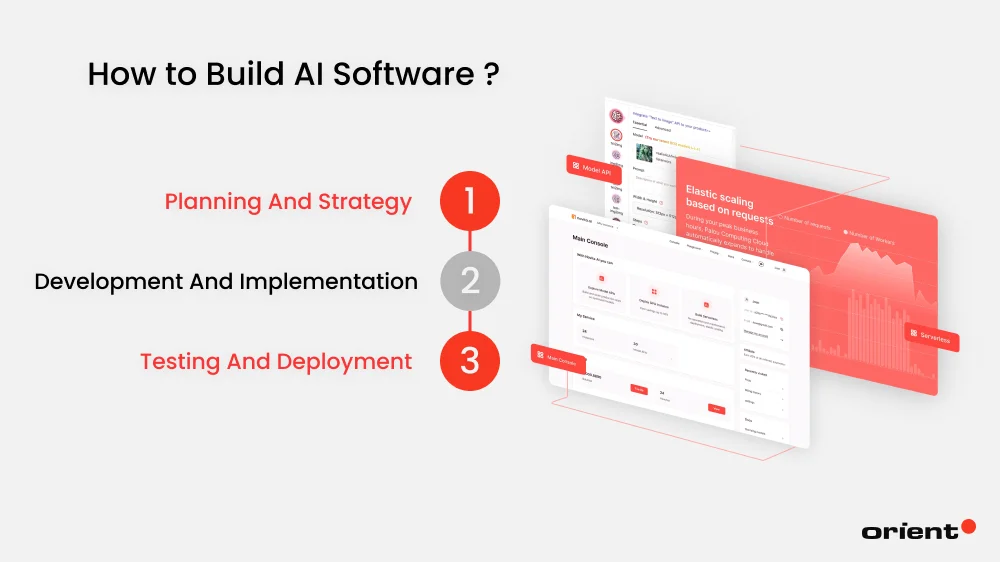
While every AI project is different, these are the typical phases in building an AI software product. It is recommended to start small with a prototype to test your ideas and earn more budget that would support more ambitious goals.
Phase 1: Planning and Strategy
Clarify Your AI Business Objectives
Don’t just chase the shiny new trend. Analyze how emerging AI technologies can truly bring value to your business. Do they solve any of your pain points that cannot be solved otherwise? What are their genuine contributions?
A lot of businesses fail in their AI undertakings because they let FOMO (fear of missing out) squander away their resources on costly but poorly fitted and futile AI projects. When it seems everyone else is doing it, think critically about why you want your own AI software. The above section may help.
Evaluate Available Data
Once you have nailed down the justifiable business objectives, consider your available data. Is your data siloed or inconsistent? The current state of your data will affect your choice of the tech stack and the skills you will need. Your business objectives and the available data significantly impact the scope of your project and, thus, the amount of investment. Therefore, ensure the first two steps are properly done - they justify the “why” of your project.
Choose The Right Tech Stack
The right tech stack should satisfy your project requirements. This includes programming languages, development tools, testing tools, cloud services, and big data solutions. You can only narrow down your options when you are clear about your project requirements. Your AI team (see below) should be able to advise on these AI solutions.

Invest in IT Infrastructure
Training machine learning models eat up a lot of computational resources. You may need to invest in extra servers, storage, and network to ensure the AI operation does not disrupt your current operation. If your business already has in place updated technologies such as cloud computing and data analytics infrastructure, then scaling them up to make space for AI capabilities is a reasonable expectation. Meanwhile, those with legacy systems will need to modernize before they can get started with AI projects.
Moreover, having an AI-ready infrastructure makes it easier to attract and build an AI team.
Build an AI Team
Three types of roles comprise a comprehensive AI team: business, data analytics, and software engineering.
The business and engineering people may be familiar with working together on previous non-AI projects, but the data specialists are likely new to the team. Consequently, the AI team needs to figure out how best to work together by answering questions such as:
How should AI projects be managed?
Consider this within the context of your company. If your company favors the Waterfall project management methodology, will it be sustainable for AI projects with high risks? To manage the risks of AI project failure, how big is the expected learning curve for your organization?
How experienced are your team members in working with AI?
AI is still a new technology requiring a major shift in mindset; adding to this is a global AI talent shortage. It is a big ask to expect that your company can compete against Big Tech for an entire team of AI experts. It is normal to have team members who will be working on an enterprise-level AI project for the first time. Make sure you have some experienced AI team members working alongside others who are willing to start their own AI journey.
Jump to the section below for more details about the key roles in an AI team.
Phase 2: Development and Implementation
Big Data Analytics

To illustrate the steps of data analytics in which your data goes through before it can be deployed into AI software development, let’s consider the Data Science Hierarchy of Needs.
Your company’s data goes through each level of the pyramid to reach the top, which is AI software development. Depending on the state of your data, you will need to set up the following framework, with several data specialists moving your data from raw to AI deployment:
- A data engineer collects structured and unstructured data.
- A data scientist cleans and prepares the data for analysis.
- A data analyst interprets and visualizes data for insights and decision-making.
- A machine learning (ML) engineer trains ML models with data to make predictions.
Deploy ML Models into AI Software Development

The software engineers deploy ML models to create artificial intelligence software during this phase. Since the risks in AI projects are high, adopting Agile into the software development cycle is better to manage risks at every phase. Specifically, the AI team should follow MLOps.
MLOps provides the framework for a software team to incorporate ML models into development. MLOps is an extension of DevOps, a practice that improves software quality with continuous feedback between operations and development.
Essentially, MLOps facilitates the collaboration between the AI software team and operations, enabling a comprehensive workflow that traverses software, hardware, and IT support. Its ability to break down silos between departments is a quality that will benefit AI software development.
Phase 3: Testing and Deployment
Testing of Software and ML Models
Just as software improves in quality through rigorous testing, ML models also benefit from continuous testing. This is because ML models are continuously updating itself with new data without human interference. Without frequent monitoring, datasets will degrade, and biases may be introduced into the datasets.
Challenges in AI Development & Solutions
Developing AI software is obviously a daunting task for even professionals. As one of the most advanced technologies today, we must admit that the challenges it introduces take work to solve.
During implementation, the development team may encounter various risks that need to be assessed. Ethical concerns in AI, for example, have long been a controversial issue. However, you can rest assured that they all have their own solutions to limit, even eliminate.
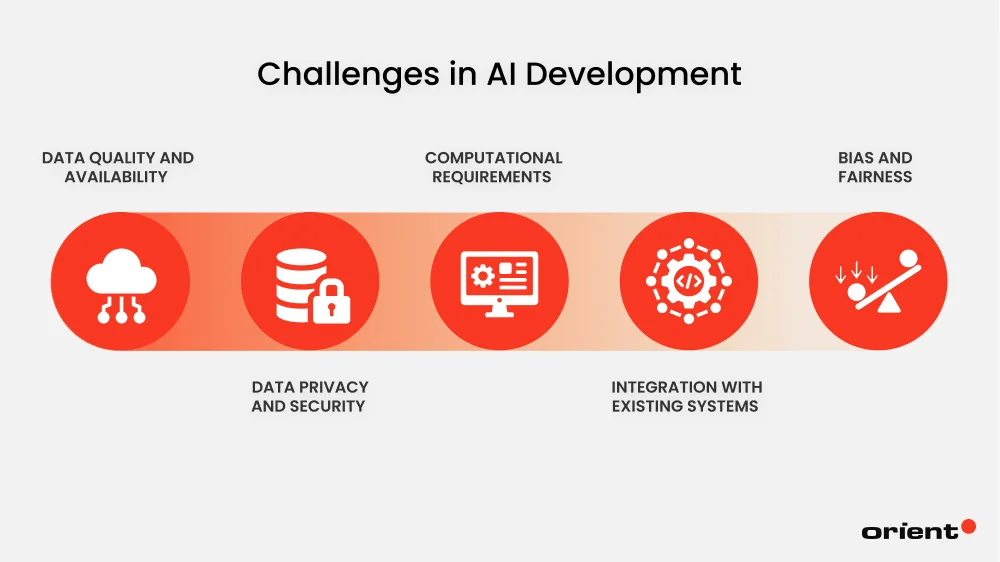
Data Quality and Availability
As discussed above, data quality plays a huge role in determining the reliability and accuracy of AI models. However, as data is collected in large quantities and made available across multiple domains, controlling data quality is always challenging. Instead, real-world data can exist in many different formats, leading to them being noisy, incomplete, or imbalanced, which is very common.
In addition, in some specific industries, such as healthcare, labeled datasets are necessary for the AI training process but are very scarce or expensive to obtain. In this case, how businesses should collect and preprocess data to obtain as much clean data as possible is a question of concern.
Our solutions:
- Use AI-driven tools to create synthetic datasets that mimic real-world data.
- Rotate images, paraphrase text, or add noise to data to train AI without collecting new data.
- Use active learning to label the most critical data points and reduce the amount of labeled data needed.
- Use privacy-preserving methods to access sensitive data without moving it from its source.
- Perform regular audits to check for anomalies in data.
Data Privacy and Security
The more data collected, the higher the risk of data security. However, experts cannot fully train their AI models without accessing user data, some of which may be sensitive or private. That’s not to mention the risks of data breaches when sharing information from small groups within an organization to serve model training, especially in cloud-based storage environments. Balancing the need for sensitive data and privacy concerns creates many barriers in AI app development.
Our solutions:
- Remove identifiable information (e.g., names, IDs, or addresses) and add statistical noise to data.
- Train AI models and input data locally on distributed servers rather than in a central location.
- Follow laws, including GDPR, CCPA, and HIPAA, to ensure compliance.
- Limit data collection to what is strictly required for the AI task.
Computational Requirements
Training AI models, deep learning models, for example, requires the contribution of thousands of computational infrastructure working simultaneously. These specialized high-performance hardware can be GPUs (Graphics Processing Units) or TPUs (Tensor Processing Units) depending on the needs of the business. Regardless of the type, they all have one thing in common: they consume enormous amounts of energy and have very expensive operating and maintenance costs.
At the same time, collecting and updating new data is a journey that lasts forever. Without the needed computational resources, the system may become overloaded at some point in the future, negatively affecting the performance of the AI model in the long run.
Our solutions:
- Develop MobileNet or DistilBERT model, which requires fewer resources.
- Train student models to replicate the performance of teacher models.
- Use pre-trained models on specific tasks instead of training from scratch.
- Remove unnecessary parameters or use lower-precision computations to reduce model size.
- Mimics human intelligence for energy-efficient AI computations.
Integration with Existing Systems
What if your AI software is incompatible with your existing infrastructure and workflows and hinders existing operations from delivering their intended value? This problem is put as an integration challenge, which is a common struggle that both large and small businesses face. Difficulty in integrating with existing systems can stem from many reasons.
If a business builds an AI app without initially thinking about compatibility with established operations, differences in data formats, frameworks, protocols, or architectures between two platforms and the lack of needed computational power will potentially lead to AI failure. For companies that still rely on legacy systems that were not designed to support modern AI technology, integration is even more impossible.
Our solutions:
- Use enterprise service buses (ESBs) or API gateways to bridge the communication gaps between systems.
- Create AI software with a primary strong focus on addressing integration challenges.
- Deploy AI solutions as modular microservices.
- Use ETL solutions such as Talend or Apache NiFi to unify and preprocess data from disparate systems.
Bias and Fairness
An AI software solution that helps scan candidates has resulted in a significantly higher number of male candidates compared to female ones. This is a simple example of bias and fairness in AI. This major challenge raises many concerns for businesses using or intending to use AI. According to recent surveys, over 70% of CEOs are concerned about delivering biased outcomes, while 40% of users distrust AI due to perceived biases and inaccuracies.
However, one thing you should know is that AI models do not naturally behave unfairly. Training data bias, in other words, training models without proactive and systemic approaches, is the main cause of a weak AI that introduces biases. So, how do we solve this challenge?
Our solutions:
- Train AI models with data that represent diverse populations and scenarios.
- Use tools like IBM AI Fairness 360 or Fairlearn to analyze datasets for imbalances.
- Include team members from different backgrounds to reduce designer bias.
- Follow industry-specific standards and anti-discrimination laws when training AI models.
Key Roles in an AI Development Team
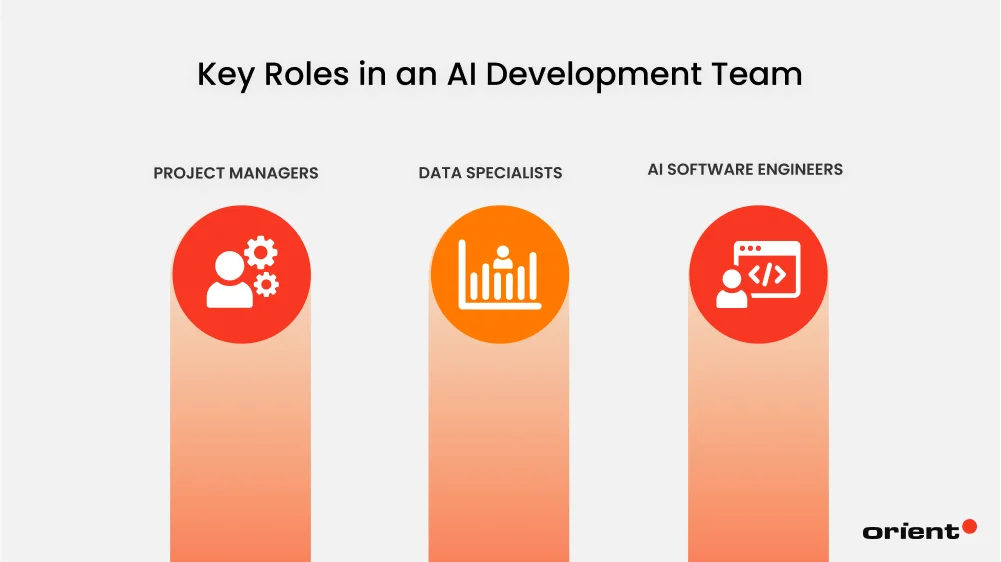
Whether you intend to develop AI software using your own in-house developers or hiring external resources to cover tasks, a typical AI team or department often consists of three key roles: business, data, and engineering.
Data literacy is the leading quality that any AI team member needs, no matter their position. It is easy to get confused about new AI algorithms. Training programs should improve the team’s competencies in working with big data so that they share the same understanding and can communicate data as meaningful information to external stakeholders.
In terms of soft skills, the most important ones are communication and teamwork, because AI software projects demand team members to work with highly collaborative frameworks to be successful.
Business Roles
These are the project managers, product managers, product owners, and business analysts. They are responsible for:
- Keep the AI team focused on the project requirements
- Ensure the AI project satisfies the business objectives and stays within time and budget constraints.
- Work with stakeholders such as legal, accounting, marketing, and investors while preventing the AI team from getting isolated from the rest of the company.
- Represent the interests of the end-users whose feedback and education will be crucial to the business success of the AI project.
Data Specialists
As mentioned above, depending on the state of your data, your AI software will need a number of data specialists: data engineers, data scientists, data analysts, and machine learning engineers. This list is not exhaustive; other roles may include database architect and data architect. They should have a mix of technical skills in maths, statistics, programming tools, cloud computing, database management, and other data-related skills.
AI Software Engineers
You may be familiar with these software engineering roles: front-end engineers, back-end engineers, testers, QA engineers, UI/UX designers, and so on. More importantly, software engineers for AI projects should have experience with or are willing to adopt DevOps and MLOps.
AI Cost: How Much Does It Cost to Build an AI System?
As complicated as it is, building AI software requires a huge investment. The AI assistant of company A does not necessarily have the same AI software development costs as the same product of company B. There is no general formula for calculating exact AI costs. Instead, these expenses vary greatly depending on factors such as project scope, type of AI, dataset size, technical complexity, etc. Your specific needs for your future artificial intelligence systems will determine the cost you need to pay for particular AI software.
However, to help you have a more general view of AI development costs by type, let’s refer to the table below.
| AI Solution Type | Estimated Cost Range (USD) | Development Time (Months) |
|---|---|---|
| Basic Chatbot | $10,000 - $50,000 | 2-3 |
| Advanced Chatbot with NLP | $50,000 - $150,000 | 4-6 |
| Predictive Analytics | $50,000 - $200,000 | 4-8 |
| Computer Vision System | $100,000 - $500,000 | 6-12 |
| Recommendation Engine | $100,000 - $500,000 | 6-12 |
| Autonomous Vehicle AI | $1,000,000 - $10,000,000 | 12-24+ |
Wrapping Up
Many have tried to build AI software, but only a few have succeeded. Even before it starts, AI software development is an enormous investment. Throughout the AI software development lifecycle, your company will be asked to invest in advanced technologies, maintain the organizational data well enough for deployment, and train your team members to work with AI technologies. If the whole process seems daunting, that’s because it is.
Not feeling ready? Consider outsourcing your first AI software project as a small, feasible start leading to a great leap down the road. By contacting us - Orient Software, you can hire AI developers at ease and start to deliver measurable outcomes.

